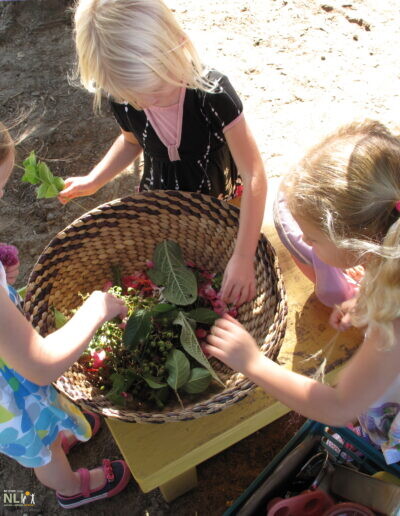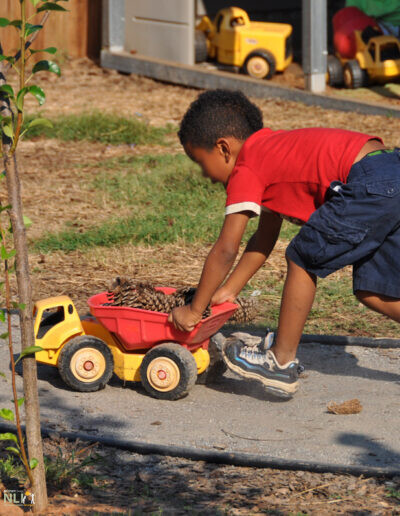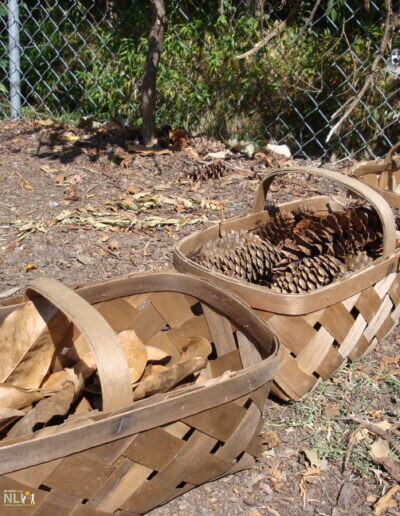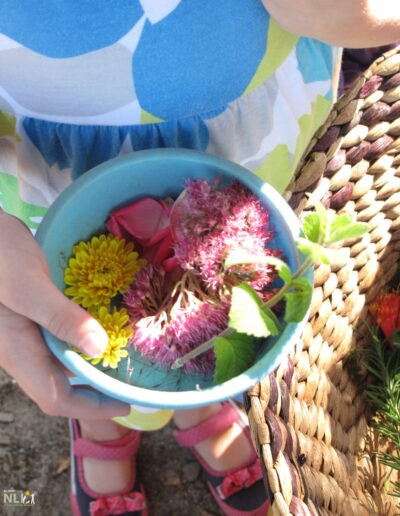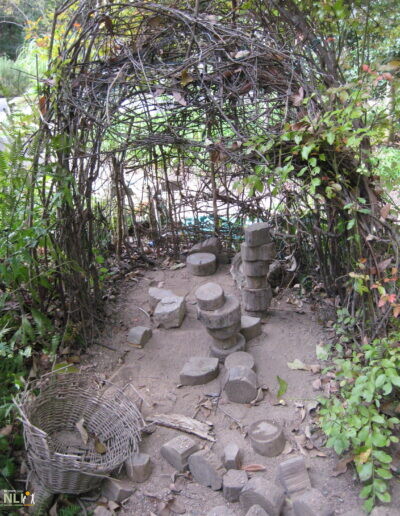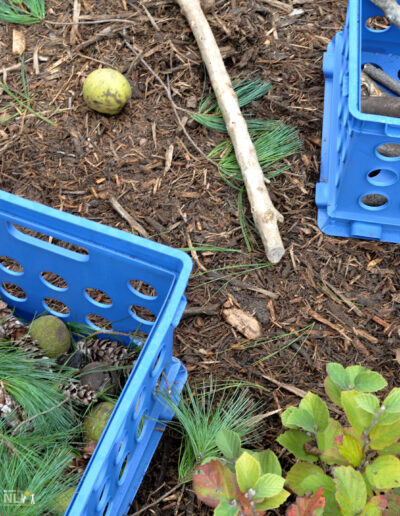42. Loose Parts Settings
Loose parts settings support a broad range of open-ended play and learning activities in a defined space, prompted by items that are small enough to be easily manipulated by preschoolers. Potential items include both natural materials as well as repurposed manufactured objects. Playful interaction with loose parts activates children’s imaginations and creativity and helps them learn early STEAM skills through hands-on combining, counting, sorting, rearranging, stacking, and more. The fundamental value of loose parts is that they are, well, loose—an essential quality and best practice. Because loose parts can be manipulated autonomously to serves children’s purposes, they enable development of agency, critical to success in life. Defined loose parts settings keep manufactured items and selected natural objects together and organized for teachers, while still encouraging independent play for children.
Types of Loose Parts
Natural. Natural loose parts include a variety of natural objects such as sticks, stones, shells, mulch, pine cones, driftwood, “tree cookies,” fallen leaves, acorns, and similar seeds, and their seedpods. The availability of some natural loose parts, such as seeds and flowers, change with the seasons while others, such as sticks and stones, are available year-round. Naturalized play and learning spaces are by definition rich in natural loose parts, while others may require teachers and children to bring natural loose parts from home or other local sources. If baskets, buckets, and push toys are available, children will “forage” for natural loose parts, incorporate them into other activities, and increase their levels of physical activity.
Manufactured. Manufactured loose parts can be created by re-purposing everyday items of all shapes and sizes. Large items include cardboard boxes and tubes, plastic pipes, crates and bins, pieces of textile and foam plastic, pieces of furniture, and items of clothing. Medium-sized items include all manner of plastic and metal containers, drink cans, plastic bottles, and cast-off kitchen utensils. Smaller items include bottle caps, beads, string, metal cans, soda tabs, and much more. Assemble a wide variety of objects with different colors, textures, and materials that maximize sensory play opportunities. Sources include kitchens, classrooms, households, and thrift stores.
Location
Locate loose activity settings near natural features that produce bountiful play and learning items, like trees, shrubs, tall grasses, and pickable flowers. Natural loose parts facilitate independent play and connect children to nature. Discuss with children what they can pick and gather outdoors. Ensure settings have sufficient shade to protect children during extended play sessions, either in the shade of trees or by installing shade components such as pergolas, umbrellas, or shade sails.
Organization and Storage
If a permanent loose parts activity setting is desired, provide adequate storage for ease of access. Storage in bins, baskets, buckets, and shelving units allows for self-guided play and facilitates easy clean-up. When possible, protect loose parts from the elements by storing them in bins with lids, in outdoor sheds, or under structures such as pergolas, lean-tos, or covered outdoor classrooms.
Complementary Settings
Both natural and manufactured loose parts complement each other and enrich outdoor play and learning in a variety of settings, including the following:
Mud kitchens/cafés. Mud kitchens/cafés allow children to make concoctions from clean dirt and water, and whatever loose parts are available at the time. A wide range of natural materials and “pickables” bring color, texture, and added sensory stimulation to mud play settings. See InfoSheet 34: Creating a Mud Kitchen.
Sand play. Sand is a classic open-ended play material that allows children to sculpt, mold, dig, and build. Adding natural and manufactured loose parts allows children to create mini-landscapes, to add texture and color to an infinite variety of sand sculptures. For more information on sand play settings, see InfoSheet 15: Sand Play Settings.
Water play. Hands-in water play can be enriched and extended with a variety of loose parts, allowing children to float, pour, and splash, to appreciate the acoustic qualities of water and observe the behavior of this intriguing liquid as it flows around objects, with sunlight glinting off its surface. Games such as “sink or float” build STEAM skills by challenging children to guess the weight and properties of different materials. See InfoSheet 40: Water Play Settings.
Outdoor classrooms. An outdoor classroom can serve as the base for more formal loose parts activities across the curriculum. Children may go on expeditions to gather diverse items, return to the “lab” outdoor classroom to count, sort, identify, name, classify, and describe different objects, or they can be used for art projects. An emphasis on natural loose parts can teach children about the seasons, how plants grow, and the cycles of nature. See InfoSheet 41: Outdoor Classrooms.
Health and Safety
- Loose parts in infant/toddler spaces should be carefully monitored to exclude potential choking hazards.
- All loose parts settings should be inspected regularly and any damaged or hazardous items removed

